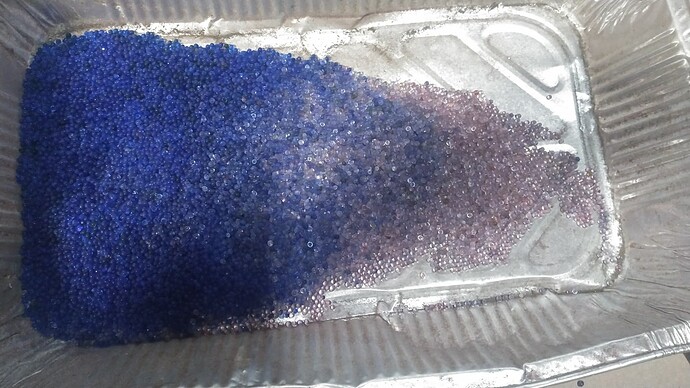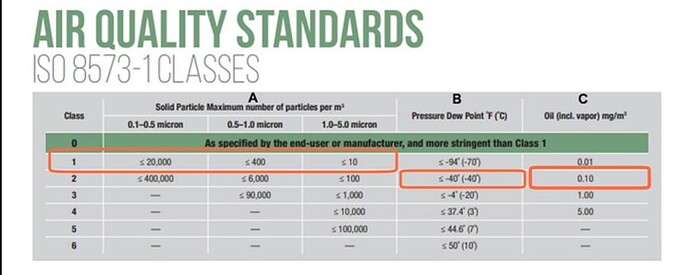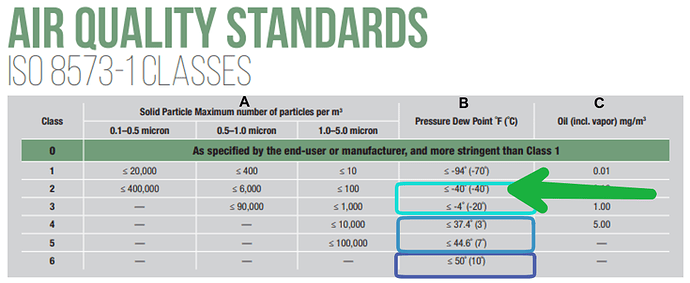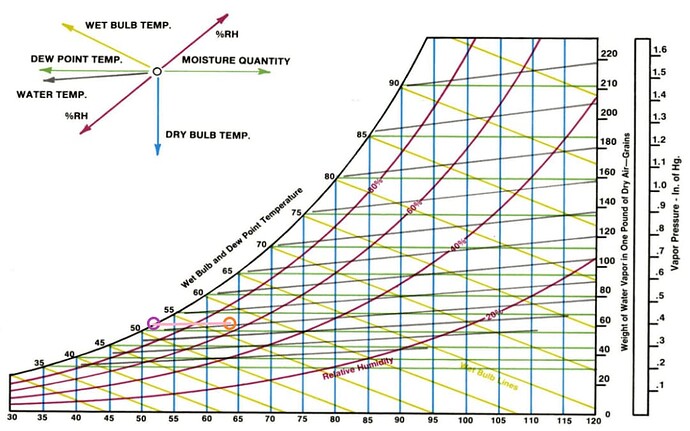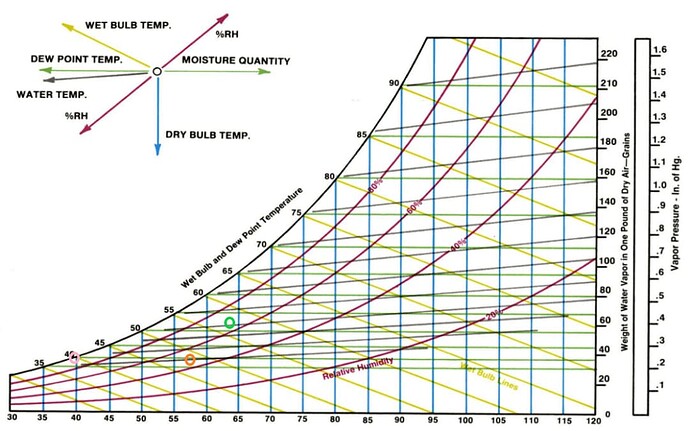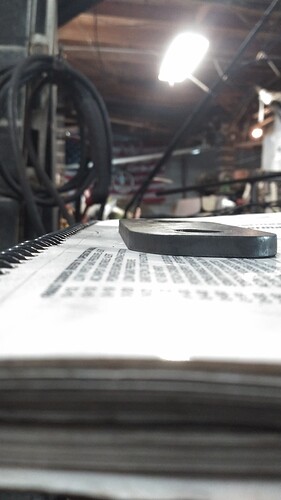Some guys make their own by converting water filter housings. I use the Max Dry XXL, it lasts quite a while between having to dry the beads.
@TinWhisperer
Our desiccant discussion on if I had my bead dryer too close to the refrigerated dryer has me wondering. Before I change any plumbing I want to figure out how much moisture is making it through the desiccant beads.
My plan is I have a small desiccant dryer I put quick connects on. I am going to hook it to one of my dry air tanks to see if and how long it takes for the beads to start to change. I have a lot of powder coating to do this weekend so I will connect my fluidized hopper feed line to this. It will be a low pressure low volume I assume it will have time to capture evidence of existing moisture.
Here is a picture of my beads out of my quart size dryer. I tried to pour the out in a way to see the transition. These have approximately 3.5 hours torch on time, about 2 hours powder coating, ran a impact enough to tighten about 200 1/2 inch nuts and just some odds and ends. I would like to see some others to compare.
Phillip, I always love your experiments. Saves us a lot of effort and often answers some questions we have.
Thanks, in advance.
I would like to think it helps someone… Even if it’s just them feeling better about themselves.
I am going to try to grab a thermometer that show humility as well this afternoon.
Another piece of information I have a airline right after the desiccant dryer. You don’t want to run a die grinder long. The thing is like holding chunk of ice.
The copper pipe run I have before my dessicant setup drops the majority of the easy to condense moisture out of the air in my lines, so my gallon of dessicant can go longer than if it was the only thing I had doing the job. On top of that my garage is heated and air conditioned, which means the air the compressor is sucking in is also not as humid as it would be otherwise.
So, keeping those two caveats in mind, I can usually go at least a couple months before the beads are mostly used up and need to be dried back out.
Yeah I don’t have wall space for a copper cooler. But I do run through two air cooled trans coolers then a refrigerated air dryer.
Mine is behind my large rolling toolbox. It only pushes the toolbox out 5" from where it’d be if I had the back of it touching the wall, essentially making the front of my toolbox and front of my compressor flush with each other, which works out fine. I used 2x45° and 1x90° fitting to make the air flow a little more smoothly around all the 180° turns, and have a total of around 100’ of 3/4" copper pipe before the dessicant, around 90’ of which is in the condensing section. I could have tightened up the spacing and probably fit 120’+ of copper condenser in the same space, but heat soaking the air in that narrow space between the wall and toolbox might eventually slow down the cooling effect anyway.
I think you’ve got plenty to take the place of a passive condenser, but for anyone looking to build a system, it’s pretty simple to put together and can be tailored to fit in just about any space. If automation is your thing, you can use automatic drains and it basically takes care of itself from there with no upkeep costs, noise, or worries about coolant leaks. Not for everyone, but works good for some of us, especially when paired with a decent dessicant dryer after it.
I have been slowly upgrading all my setups. My plasma, air, and powder coating. The idea I have been pondering is tin brought up the idea that desiccant work best around 70 to 90 degrees. I am wondering if having the beads directly after the refrigerated dryer bay be hindering their ability to adsorb moisture.
That makes sense logically to me, but how much more work will the dessicant really be doing anyway with how good your aftercooler and refrigerated setup is already? I don’t doubt it would help the dessicant work better if the air was warmer, but it may be splitting a fairly small fraction into a slightly smaller fraction of moisture by raising it to ambient.
I’d be curious if you noticed any practical difference in consumable life if you had 20-30’ of copper between the refrigerated dryer and dessicant to bring the compressed air temp up in between? The slowness of your beads to change color during use may just be mostly a sign that you already have pretty dry air going into your dessicant cannister. I mean, it’s hard to believe it’s not drier than the air getting to my dessicant, you certainly have better hardware doing the job, and even my dessicant lasts a pretty long time, even accounting for it being 4x the volume.
Each different piece of equipment is effective at removing moisture in a different range.
This is the standard you should be aiming for.
ISO 8573-1
Class 1.2.2
Column b deals with water vapor.
The dark blue is where a passive or active ambient air cooler will get you to.
The blue color is where a refrigerated air dryer will get you to.
And the light blue is where a desiccant cell will get you to.
Maybe toggling on and off the refrigerated air dryer when the indoor ambient temperature is 38f or less.
At 38f a passive cooler will act almost the same as a refrigerated dryer anyhow.
Pressure dew point monitoring would be the way.
If you had a valve and union on either side of your desiccant you could isolate and remove that assembly to weigh it before and after use. You could determine how much water was adsorbed. The canister would have to be isolated from atmosphere to get a good measure because it will start losing water to the air in left open.
@MrHaNkBoT curiosity just grabbed me on this one. Really if @TinWhisperer hand not brought up the fact that desiccant beads don’t work well in hot air I never would have even thought that maybe the opposite may be true also.
I started last night working on a couple large pieces I need to finish this weekend. I will be doing some sandblasting and powder coating . I put together a small desiccant filter that I attached to one on my dry air tanks. I am sure it will eventually start to change colors but curious how long it will take. I don’t have anything to compare to so making a judgement will take some time I believe.
If I determine that they may not be working to the best of there abilities I will probably add another small tank in between the two to see how that does.
I frequently get 1500 pierces and several hour of torch time cutting 1/4 material with decent cut quality considering. I have and could get more but I feel no point in pushing it they certainly have paid for themselves.
@TinWhisperer I bought a gauge last night set it next to my compressor it was raining pretty hard and had rained off and on nearly all day yesterday. I set it up coming out of the package it showed 35 percent i set it up about 8 last night. I did have the garage doors so that would be a factor. When I shut down about 1 last night the temp was 63 inside and humidity was 65 percent😬.
I can see maybe the beads not working great seeing temps in the 30s but with the after cooler and refrigerated they should see any more humid air than anyone else’s if my equipment is working up to par.
I am really just curious to see i may find out and value input from others. This may not help me but someone else later.
at those figures (orange circle) condensation will start to condensate on surfaces at <52f (purple circle)
This is the best explanation i can find so far
"In order for the water molecule to adhere to the surface of the desiccant, it must have sufficient kinetic energy to overcome these attractive forces and transition from the gas phase to the solid phase. If the water molecule lacks the necessary energy, it will not be able to overcome these forces and will simply bounce off the surface, remaining in the gas phase.
At lower temperatures, the kinetic energy of water molecules is reduced, meaning they move more slowly and have less energy. As a result, fewer water molecules possess the energy required to overcome the energy barrier and adsorb onto the surface of the desiccant material. This reduction in the number of molecules capable of adsorption leads to a decrease in the rate of adsorption, slowing down the process of moisture removal from the air."
So if my setup isn’t working at is best I should see the desiccant beads start to change colors some downstream withing few hours of operation.
@TinWhisperer we are at 57 and 48 percent humidity right now
here is a good summary of why this is the case
"At higher temperatures, the molecules within the desiccant material become more agitated, vibrating with greater energy. This increased thermal motion disrupts the intermolecular forces that typically facilitate the adsorption of water molecules onto the surface of the desiccant. These forces, which include van der Waals interactions and hydrogen bonding, are essential for capturing water molecules from the air. However, when disrupted by thermal vibrations, they become less effective, impeding the desiccant’s ability to efficiently remove moisture from the air. Consequently, despite the higher kinetic energy of water molecules at elevated temperatures, the compromised intermolecular forces within the desiccant material lead to reduced adsorption effectiveness, resulting in decreased moisture removal efficiency.
"
I really respect/appreciate the detailed information that you bring to conversations.
57f48rh (orange circle) condensation will start to condensate on surfaces at <40f (purple circle)
63f65rh (green circle)
you lost alot of water vapour overnight. do some surface feel wet in the morning around the shop?
Nope I have two large lathes “large heatsinks”. I say that because at work when humidity is high we have to keep the equipment oiled they sweat bad. I have seen other people working around older cast iron equipment say the same thing.
I was referring more to the fact that his aftercoolers and refrigerated dryer were doing the heavy lifting, and I suspected the RH% after his dessicant might not change all that dramatically if the only change he made was letting the air get a bit warmer before getting to the dessicant (not “using” VS “not using” the dessicant).
I’m definitely out of my league when it comes to knowing all the science behind the limits of the systems for removing moisture and the really granular details of how to optimize them to the Nth degree. It’s not something I have ever gotten super excited about enough to do a bunch research, but hearing how many pierces and cuts @Phillipw gets out of a set of consumables on 1/4", maybe my air isn’t as dry as I think despite the big copper run and large dessicant setup. I do a lot of mixed thickness cutting with my Primeweld Cut 60, but probably get half that many pierces cutting 1/4" and less mild steel.
